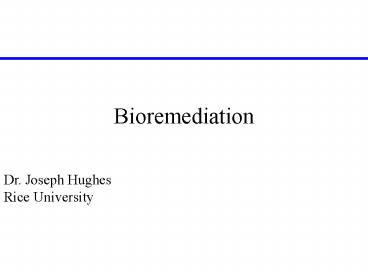Bioremediation PowerPoint PPT Presentation
1 / 39
Title: Bioremediation
1
Bioremediation
Dr. Joseph Hughes Rice University
2
Bioremediation
- Use of microorganisms to breakdown organic
contaminants. - Biodegrade
- Mineralize
- Biotransform
- Use of microorganisms to transform inorganic
compounds to immobile or non-hazardous forms
3
Organisms Involved
- The microbes whose ecosystem function is to carry
out decay - Bacteria
- Fungi
4
Carbon Cycle
CO2
Photosynthesis
Organic Material in Soils and Sediments
Animals
Dead Plants Bacteria and Animals
Biochemical Cycle (Days) Aerobic 1012 Tons
Geochemical Cycle (Millions of years) Anaerobic
1016 Tons
5
Soil and Subsurface Contaminants
- Benzene and related fuel components
- Pyrene and other polynuclear aromatics
- Chlorinated aromatics and solvents
- Phenolic wood treating derivatives
- Herbicides and pesticides
- Nitroaromatic explosives and plasticizers
6
Fuel Components
Aliphatics
Aromatics
7
Polynuclear Aromatic Hydrocarbons
8
Chlorinated Aromatics
9
Chlorinated Solvents
Ethenes
Methanes
Ethanes
10
Nitroaromatics
11
The 25 Most Frequently Detected Ground Water
Contaminants at Hazardous Waste Sites
1. Trichloroethylene 2. Lead 3.
Tetrachloroethylene 4. Benzene 5.
Toluene 6. Chromium 7. Methylene
chloride 8. Zinc 9. 1,1,1-Trichloroethane 10.
Arsenic 11. Chloroform 12.
1,1-Dichloroethane 13. 1,2-Dichloroethene
14. Cadmium 15. Manganese 16. Copper 17.
1,1-Dichloroethene 18. Vinyl chloride 19.
Barium 20. 1,2-Dichloroethane 21.
Ethylbenzene 22. Nickel 23. Di(2-ethylhexyl)phth
alate 24. Xylenes 25. Phenol
12
Microbial Infallibility
- The empirical observation that no natural
organic compound is totally resistant to
biodegradation provided that environmental
conditions are favorable (Alexander, 1965)
13
Three Forms of Contaminant Metabolism
- Primary metabolism
- Electron donor reactions
- Oxidation yields energy
- Electron acceptor reactions
- Reduction to balance oxidation
- Cometabolism
- Fortuitous reaction without energy gain
- Secondary metabolism
14
Transformation Processes
15
Bioremediation Practice
- Understand physical and chemical characteristics
of the contaminants of interest. - Understand the possible catabolic pathways of
metabolism and the organisms that possess that
capability - Understand the environmental conditions required
to - Promote the growth of desirable organisms
- Provide for the expression of needed organisms
- Engineer (i.e., alter in a controlled manner) the
environmental conditions needed to establish
favorable conditions and contact between
organisms and contaminants.
16
Historical Perspective
17
Bioremediation Market Assessment
- 100 million tons of hazardous wastes generated
annually - One third of over 2 million gasoline Underground
Storage Tanks are leaking - Over 50,000 historically contaminated sites
- All United States federal installations require
extensive remedial action - Estimated cost of 1,700,000,000,000
18
Outline
19
Principles of Subsurface Microbiology
20
Microorganisms in the Subsurface
- EUKARYOTES
- Fungi
- Algae
- Protozoa
- PROKARYOTES
- Eubacteria
- Archaebacteria
Used in Bioremediation
21
Bacterium
- Single Cell Organisms
- DNA
- Contains genetic code
- Ribosomes
- Protein production
- rRNA
- Enzymes
- Catalyze reactions
Ribosome
.
.
.
.
.
.
.
.
.
.
.
.
.
.
.
Cell Wall
22
Microbial Numbers
- Surface Soils rhizosphere
- 108 1010 total cells/GDW
- Subsurface Material - from rhizosphere to 600 ft
- 106 to 108 total cells/GDW
- Fresh Water
- 106 total cells/ml
- Oligotrophic vs eutrophic
- Ground Water ?????
23
Key Concepts of Microbiology
- Metabolism is simple, individually
- Collectively, metabolism is extremely diverse
- Bacteria must be alive, and conditions must be
appropriate, for desired metabolism - Activity influenced by environmental factors
- Temperature, pH, toxicants, etc.
24
Microbial Communities
- Number of all organisms in a given location
- Communities represent higher genetic and
metabolic diversity than pure cultures - Often required to degrade complex organics
- Consortia act together
- Potential for sequential degradation
25
The Bacterial Engine
26
Fueling the Bacterial Engine
- Reduced Chemical (e-) Oxidized
Chemical
(Electron Donor Food)
Cellular Synthesis
Energy
(ATP)
Cellular Maintenance
Oxidized Chemical Reduced Chemical
(e-)
(Electron Acceptor)
Metabolism is the sum total of all the chemical
processes of the cell
27
Electron Acceptors
Increasing
Decreasing
Growth rates under normal conditions
28
Growth Kinetics
1. Lag phase 2. Exponential growth 3. Stationary
phase 4. Decay phase
29
Factors that Influence Growth
- Nutritional
- Carbon Source
- Energy Source
- Electron Acceptor
- Nutrients
- Physical
- Temperature
- pH
- Absence of Toxicants
- Contact
- Time
30
Temperature
- Psychrophiles
- 0 - 20 C
- Mesophiles
- 10 - 45C
- Thermophiles
- 45 - 75 C
- Extreme thermophiles 70 - 110 C
Optimum temperature
Increasing Growth Rate
Increasing Temperature
31
pH
- Acidophiles
- pH lt 5
- Neutralophiles
- 5 gt pH gt 9
- Alkaliphiles
- pH gt 9
Increasing Growth Rate
pH
32
Oxygen
- Aerobes
- Obligate oxygen required
- Facultative oxygen not required faster growth
with aerobic conditions - Microaerophyllic oxygen required at partial
pressures lower than atmospheric - Anaerobes
- Aerotolerant oxygen does not affect organisms
- Obligate oxygen is toxic
33
Nutritional Factors
- Electron donor
- Carbon source
- Electron acceptor
- Marco-nutrients N, P, S, Fe, .
- Micro-nutrients Zn, Co, Ni, .
- All must be present in a usable form!!!
34
Monod Kinetics
Saturating rate (?max)
Growth Rate (?)
0.5 (?max)
Half-velocity coefficient
Substrate Concentration
35
Growth Kinetics
Growth limited by one or more substrates
Microbial Growth
First Order Decay
Monod Kinetics
36
Effect of KS
Ks increasing
Growth Rate
Substrate Concentration
37
Effect of k
Growth Rate
increasing k
Substrate Concentration
38
Adaptation versus Acclimation
Adaptation (population shift)
Acclimation (enzyme expression)
DNA
Degradation
mRNA
Protein
39
Break

